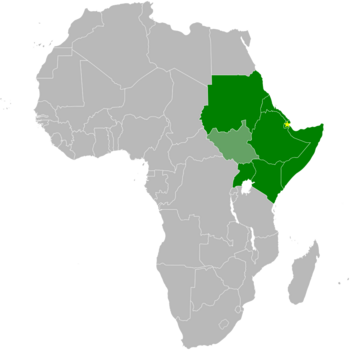Intergovernmental Authority on Development facts for kids
Quick facts for kids
Intergovernmental Authority on Development (IGAD)
الهيئة الحكومية للتنمية
Autorité intergouvernementale pour le développement |
|
|---|---|

Member states
|
|
| Headquarters | |
| Official languages | English |
| Membership | |
| Leaders | |
|
• Chair
|
|
|
• Executive Secretary
|
Workneh Gebeyehu |
| Establishment | January 1986 (As IGADD) 1996 |
| Area | |
|
• Total
|
5,204,977 km2 (2,009,653 sq mi) |
| GDP (PPP) | estimate |
|
• Total
|
$337.82 billion |
| GDP (nominal) | estimate |
|
• Total
|
$393.042 billion |
|
• Per capita
|
$888.5 |
| Time zone | UTC+3 (East Africa Time) |
The Intergovernmental Authority on Development (IGAD) is a group of eight countries in Africa. It helps these countries work together on important issues. Think of it like a team of nations.
IGAD's main office, called its Headquarters, is in Djibouti. The group includes countries from the Horn of Africa, the Nile Valley, and the African Great Lakes region.
Contents
Who are the Members?
IGAD has eight member countries. Most of them joined when the group first started.
Countries in the Horn of Africa
 Djibouti (joined in 1986)
Djibouti (joined in 1986) Ethiopia (joined in 1986)
Ethiopia (joined in 1986) Somalia (joined in 1986)
Somalia (joined in 1986) Eritrea (joined in 1993, left for a while, and rejoined in 2023)
Eritrea (joined in 1993, left for a while, and rejoined in 2023)
Countries in the Nile Valley
 Sudan (joined in 1986, but its participation was paused in 2024)
Sudan (joined in 1986, but its participation was paused in 2024) South Sudan (joined in 2011, but its participation was paused in 2021)
South Sudan (joined in 2011, but its participation was paused in 2021)
Countries in the African Great Lakes
How IGAD Started
IGAD was officially created in 1996. But its story began earlier, in 1986. Back then, it was called the Intergovernmental Authority on Drought and Development (IGADD).
IGADD was formed by Djibouti, Ethiopia, Somalia, Sudan, Uganda, and Kenya. Its main goals were to help with development and control environmental problems, especially drought. The main office for IGADD was moved to Djibouti in 1986.
In 1993, Eritrea joined the group after it became an independent country.
Leaders from these countries met in 1995. They decided to work even more closely together. This led to the creation of the new and improved IGAD in 1996.
Helping Somalia
IGAD has played a big role in helping Somalia.
In 2006, IGAD suggested sending a peace mission to Somalia. This mission was called IGASOM. Later, in 2007, the United Nations Security Council approved a new mission. This new mission was called the African Union Mission to Somalia (AMISOM). It took the place of IGASOM.
IGAD strongly supports the government of Somalia. It has helped through missions like AMISOM and ATMIS.
IGAD also started new projects in 2008. These projects aimed to make it easier for countries to invest, trade, and do banking. The group focuses on using new and smart ideas to help its members.
How IGAD Works
IGAD has a clear structure to help it do its work.
- The Assembly of Heads of State and Government is the most important part. It's made up of the leaders of each member country. They decide on IGAD's main goals and plans. They meet once a year and choose a new leader for the group.
- The Secretariat is like the main office that runs things day-to-day. It's led by an Executive Secretary. This person helps countries create regional projects. They also help make sure development plans are coordinated. The current Executive Secretary is Workneh Gebeyehu from Ethiopia.
- The Council of Ministers includes the foreign affairs ministers from each country. They approve IGAD's plans and budget twice a year.
- The Committee of Ambassadors is made up of ambassadors from member countries. They give advice and guidance to the Executive Secretary.


